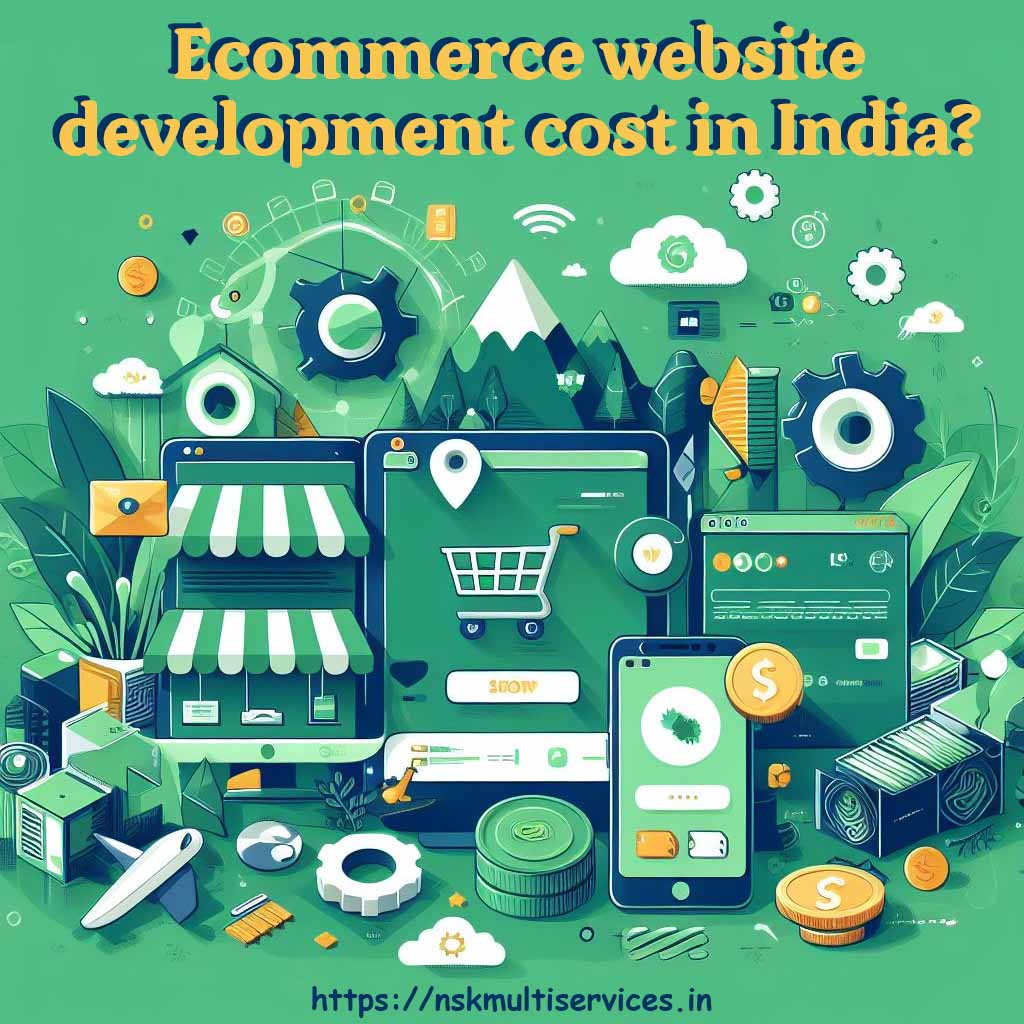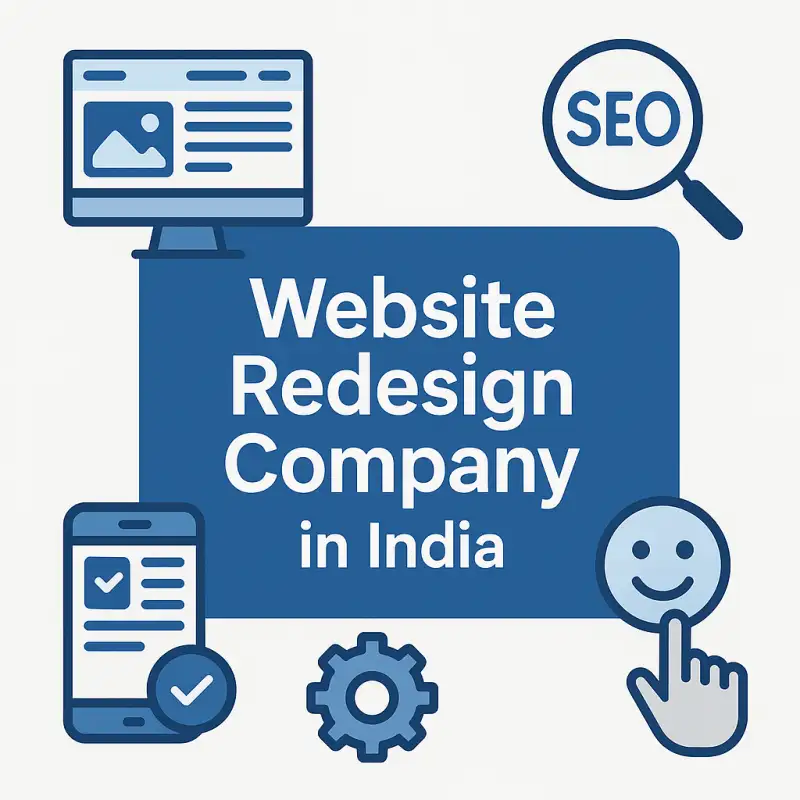Ecommerce website development cost in India? - NSK MultiServices

Ecommerce website development cost in India?
Ecommerce website development cost in India: In this digital era, having an e-commerce website for your business has become a necessity. It provides an opportunity to reach a wider audience and increase sales. However, one of the biggest questions that businesses often have when considering an e-commerce website is how much it will cost to develop. In this article, we’ll explore the factors that affect e-commerce website development costs in India.
In short: Ecommerce website development cost in India varies based on factors like platform choice, customization needs, ranging approximately from INR 10,000 to INR 500000 or above.”
What is Ecommerce Website development Process?
Ecommerce website development refers to the process of creating and building online platforms that enable businesses to sell products or services to customers over the internet. It involves the design, development, and implementation of digital storefronts where transactions can take place securely and efficiently. Ecommerce websites come in various forms, ranging from simple online stores to complex multi-vendor marketplaces, and they are tailored to meet the unique needs and objectives of each business.
1) Ecommerce Websites
1.1) Importance of Ecommerce Websites for Businesses:
In today’s digital era, ecommerce websites play a crucial role in the success and growth of businesses across industries. Here’s why they are indispensable:
Also read : Do you need a website for your Business?
- Global Reach: Ecommerce websites break geographical barriers, allowing businesses to reach customers worldwide and tap into new markets beyond their physical locations.
- 24/7 Accessibility: Unlike brick-and-mortar stores with fixed operating hours, ecommerce websites are accessible 24/7, providing customers with the convenience of shopping anytime, anywhere.
- Increased Sales Opportunities: By expanding their online presence, businesses can capitalize on the growing trend of online shopping and unlock new sales opportunities, driving revenue growth.
- Cost-Effectiveness: Compared to traditional retail establishments, ecommerce websites often require lower overhead costs, such as rent, utilities, and staffing, making them a cost-effective option for businesses of all sizes.
- Data-driven Insights: Ecommerce platforms generate valuable data and analytics that businesses can leverage to understand customer behavior, preferences, and purchasing patterns, enabling them to make informed decisions and optimize their marketing strategies.
- Enhanced Customer Experience: With features like personalized recommendations, secure payment gateways, and seamless navigation, ecommerce websites provide customers with a streamlined and enjoyable shopping experience, fostering loyalty and repeat business.
- Scalability and Flexibility: Ecommerce websites are highly scalable and adaptable, allowing businesses to easily expand their product offerings, update inventory, and introduce new features as their operations grow and evolve.
1.2) Key Components of Ecommerce Website Development:
Building a successful ecommerce website involves integrating various components to create a cohesive and functional online platform. Here are the key components:
- User Interface (UI) Design: The visual layout and design elements of the website, including colors, typography, and imagery, play a crucial role in attracting and engaging visitors.
- Product Catalog Management: A comprehensive product catalog with detailed descriptions, images, and pricing information helps customers make informed purchasing decisions.
- Shopping Cart and Checkout Process: An intuitive shopping cart system and streamlined checkout process ensure a seamless and hassle-free transaction experience for customers.
- Payment Gateway Integration: Secure payment gateway integration allows customers to make payments using various methods, such as credit cards, debit cards, digital wallets, and net banking.
- Order Management System: An efficient order management system enables businesses to track orders, manage inventory, and fulfill customer requests in a timely manner.
- Security Features: Robust security measures, such as SSL encryption, PCI compliance, and fraud detection, protect sensitive customer data and instill trust in the online shopping experience.
- Search Engine Optimization (SEO): Implementing SEO best practices ensures that the ecommerce website ranks well in search engine results, driving organic traffic and visibility.
- Responsive Design: A responsive design ensures that the website is optimized for various devices and screen sizes, providing a consistent user experience across desktops, tablets, and smartphones.
By incorporating these key components into the ecommerce website development process, businesses can create compelling online storefronts that attract customers, drive sales, and achieve their business objectives effectively.
2) Factors Influencing Ecommerce Website Development Costs:
i) Website Design and Customization:
The level of customization and complexity of design elements impact development costs. Custom-designed websites require more time and resources compared to using pre-designed templates.
ii) Ecommerce Platform Selection:
Each ecommerce platform (e.g., Shopify, WooCommerce, Magento) comes with its own pricing structure, ranging from subscription fees to transaction fees. Additionally, customizing and integrating third-party plugins can affect costs.
iii) Features and Functionalities Required:
The breadth and depth of features needed, such as product catalog management, shopping cart functionality, and payment gateway integration, influence development costs. Advanced features like multi-language support or subscription-based models may require additional customization.
iv) Mobile Responsiveness and Compatibility:
Ensuring that the ecommerce website is mobile-friendly and compatible with various devices and screen sizes adds to development costs. Responsive design implementation and thorough testing across different platforms are essential.
v) User Experience (UX) and User Interface (UI) Design:
Investing in user-centric design elements and intuitive navigation enhances the user experience but may incur higher design and development costs. Customized UI/UX design tailored to the target audience can differentiate the ecommerce website and drive conversions.
vi) Content Management System (CMS) Integration:
The choice of CMS affects development costs, with some platforms offering more flexibility and customization options than others. Integrating a robust CMS for content management, such as WordPress or Drupal, may require additional development efforts.
vii) Third-Party Integrations:
Integrating third-party systems like customer relationship management (CRM) or enterprise resource planning (ERP) software can streamline operations but may involve additional development work and costs for customization and API integration.
viii) Security Features:
Implementing robust security measures, such as SSL certificates and PCI compliance, is essential for protecting customer data and ensuring secure transactions. Investing in advanced security features may incur higher development costs but is crucial for building trust with customers.
ix) Search Engine Optimization (SEO) Considerations:
Incorporating SEO best practices into the website’s structure, content, and technical elements helps improve visibility in search engine rankings. Development efforts focused on SEO optimization, such as clean code, fast loading times, and mobile-friendliness, impact overall costs.
x) Scalability and Future Growth Potential:
Building a scalable ecommerce website that can accommodate future growth and evolving business needs requires careful planning and investment. Scalability features like flexible architecture, modular design, and scalable hosting solutions contribute to development costs but ensure long-term viability.
3) Cost Breakdown of Ecommerce Website Development:
3.1) Domain Registration and Hosting Costs:
Domain registration involves purchasing a unique web address (URL) for your ecommerce website. In India, domain registration costs typically range from ₹500 to ₹2000 per year, depending on the domain extension (.com, .in, .co.in, etc.) and the registrar.
Hosting costs refer to the fees associated with renting server space to store your website files and make them accessible on the internet. Shared hosting plans, which are suitable for small to medium-sized ecommerce websites, can range from ₹500 to ₹3000 per month. VPS (Virtual Private Server) hosting and dedicated hosting are more expensive options, with prices ranging from ₹2000 to ₹10,000 per month or more, depending on the server specifications and provider.
3.2) Website Design and Development Fees:
Website design and development fees cover the cost of creating the visual layout, user interface (UI), and functionality of your ecommerce website. In India, freelance web designers may charge anywhere from ₹10,000 to ₹50,000 or more for a basic ecommerce website, while established web development agencies may charge upwards of ₹50,000 to ₹5,00,000 or more, depending on the complexity of the project and the level of customization required.
3.3) Ecommerce Platform Subscription or Licensing Fees:
Ecommerce platform subscription or licensing fees refer to the cost of using a specific ecommerce platform to build and manage your online store. Popular ecommerce platforms in India, such as Shopify, WooCommerce, and Magento, offer a range of subscription plans or licensing options to suit different business needs and budgets. Subscription fees can range from ₹500 to ₹10,000 or more per month, depending on the platform and plan selected.
3.4) Payment Gateway Setup and Transaction Fees:
Payment gateway setup fees typically include one-time setup charges for integrating a payment gateway into your ecommerce website. In India, payment gateway setup fees can range from ₹0 to ₹10,000 or more, depending on the payment gateway provider and any additional services required.
Transaction fees are charged for each online transaction processed through the payment gateway. Transaction fees typically range from 1% to 3% of the transaction amount, plus a fixed per-transaction fee of ₹1 to ₹10 or more, depending on the payment gateway provider and the volume of transactions processed.
3.5) SSL Certificate Purchase and Installation Costs:
SSL (Secure Sockets Layer) certificates are essential for securing online transactions and protecting sensitive customer information on ecommerce websites. SSL certificate costs vary depending on the type of certificate (e.g., single-domain, wildcard, or EV SSL) and the certificate authority (CA) issuing the certificate. In India, SSL certificate prices can range from ₹1000 to ₹10,000 or more per year.
3.6) Third-Party Plugin or Extension Costs:
Third-party plugins or extensions add additional functionality to your ecommerce website, such as advanced inventory management, customer relationship management (CRM), email marketing integration, and more. The cost of third-party plugins or extensions varies depending on the developer, functionality, and licensing model. Prices can range from free to hundreds or even thousands of rupees per year for premium plugins or extensions.
3.7) Maintenance and Support Fees:
Maintenance and support fees cover ongoing updates, bug fixes, security patches, and technical support for your ecommerce website. Some web development agencies include maintenance and support services as part of their website development packages, while others may charge additional fees for ongoing maintenance and support. Prices can range from ₹1000 to ₹20,000 or more per month, depending on the level of service required.
3.8) Marketing and Promotion Expenses:
Marketing and promotion expenses are essential for driving traffic to your ecommerce website and generating sales. In India, common marketing and promotion strategies for ecommerce websites include search engine optimization (SEO), pay-per-click (PPC) advertising, social media marketing, email marketing, content marketing, influencer marketing, and affiliate marketing. Costs for marketing and promotion can vary widely depending on the channels and tactics used, as well as the competitiveness of your industry. Budgets can range from ₹5000 to ₹1,00,000 or more per month, depending on your business goals and marketing objectives.
4) Hiring Ecommerce Website Development Professionals:
4.1) Choosing the right ecommerce website development company or freelancer
When it comes to selecting the right ecommerce website development partner, businesses must conduct thorough research to find a reputable and reliable company or freelancer. Consider factors such as their experience, expertise, and track record in ecommerce website development. Look for companies or freelancers with a proven history of delivering high-quality projects that align with your business objectives. Additionally, assess their portfolio to evaluate the quality of their work and ensure they have experience developing ecommerce websites similar to your requirements.
4.2) Factors to consider when evaluating development partners
Several factors should be taken into account when evaluating potential development partners for your ecommerce website project. Firstly, consider their experience and expertise in ecommerce website development, including their knowledge of industry best practices and emerging trends. Secondly, assess their portfolio to gauge the quality of their previous work and determine if they have successfully completed projects similar to yours. Additionally, read reviews and testimonials from past clients to get insights into their reputation and customer satisfaction levels. Lastly, consider factors such as communication skills, responsiveness, and professionalism, as these qualities are crucial for a successful partnership.
4.3) Negotiating project timelines and pricing
Once you’ve identified potential development partners, it’s essential to negotiate project timelines and pricing to ensure that both parties are aligned on expectations and deliverables. Clearly outline your project requirements, including the scope of work, desired features, and any specific deadlines or milestones. Discuss pricing models, such as fixed-price contracts, hourly rates, or retainer agreements, and negotiate a fair and transparent pricing structure that fits within your budget. Additionally, establish clear project timelines and milestones to track progress and ensure timely delivery of the project.
4.4) Ensuring clear communication and collaboration throughout the development process
Effective communication and collaboration are essential for the success of any ecommerce website development project. Establish open and transparent communication channels with your development partner, whether it’s through email, phone calls, or project management tools. Regularly communicate updates, feedback, and any changes to project requirements to ensure everyone is on the same page. Encourage collaboration and input from both parties throughout the development process, fostering a collaborative and productive working relationship. By prioritizing clear communication and collaboration, you can mitigate misunderstandings, address issues promptly, and ensure the successful delivery of your ecommerce website project.
5) Tips for Cost Optimization and ROI Maximization:
In the competitive landscape of ecommerce, optimizing costs while maximizing return on investment (ROI) is paramount for long-term success. Here are some practical tips to achieve cost efficiency and drive profitability:
5.1) Prioritizing Essential Features and Functionalities:
Before diving into website development, identify the core features and functionalities essential for your ecommerce business. Focus on elements that directly contribute to user experience, conversion rates, and sales. By prioritizing essential features, you can allocate resources more efficiently and avoid unnecessary expenses on non-critical components.
5.2) Utilizing Open-Source Platforms and Templates:
Consider leveraging open-source ecommerce platforms and pre-designed templates to reduce development costs. Platforms like WooCommerce (built on WordPress) and OpenCart offer robust features and flexibility at a fraction of the cost compared to custom solutions. Additionally, using pre-designed templates can expedite the development process, saving both time and money while still allowing for customization to align with your brand identity.
5.3) Implementing Cost-Effective Marketing Strategies:
Invest in cost-effective marketing strategies that deliver maximum impact without breaking the bank. Utilize digital marketing channels such as social media, email marketing, and search engine optimization (SEO) to reach your target audience efficiently. Experiment with targeted advertising campaigns, influencer partnerships, and referral programs to drive traffic and conversions while keeping costs in check.
5.4) Monitoring and Analyzing Website Performance Metrics:
Regularly monitor and analyze key performance metrics to identify areas of improvement and optimize website performance. Track metrics such as website traffic, conversion rates, average order value, bounce rates, and customer acquisition costs (CAC). Use analytics tools like Google Analytics and Hotjar to gain insights into user behavior, preferences, and pain points, allowing you to make data-driven decisions to enhance the user experience and drive conversions.
5.5) Implementing Iterative Improvements Based on User Feedback and Market Trends:
Continuously solicit feedback from users through surveys, reviews, and usability testing to understand their needs, preferences, and pain points. Use this feedback to make iterative improvements to your website, addressing any usability issues, enhancing features, and optimizing the overall user experience. Stay attuned to market trends, emerging technologies, and competitor strategies to adapt quickly and stay ahead of the curve.
By following these tips for cost optimization and ROI maximization, ecommerce businesses can streamline operations, drive efficiencies, and achieve sustainable growth in today’s competitive digital marketplace.
Related Articles
- Low cost website design company in India
- What is website short answer
- Terms and Conditions
- NSK Multiservices – Home
- What is SEO – Hindi
Wrapping up
Ecommerce website development in India is dynamic and multifaceted, with costs varying significantly based on several key factors. Design complexity, platform selection, required features, and ongoing maintenance all play crucial roles in determining the overall investment required for building an ecommerce website. However, armed with a comprehensive understanding of these factors and a strategic approach to cost optimization and ROI maximization, businesses can navigate the development process effectively.
- It’s essential to prioritize the features and functionalities that align with your business objectives and target audience preferences.
- Selecting the right ecommerce platform is paramount. While there are numerous options available, each with its own set of pros and cons, it’s crucial to choose a platform that not only meets your current needs but also offers scalability and flexibility for future growth.
- Furthermore, ongoing maintenance and support are critical aspects of ecommerce website ownership. Regular updates, security patches, and bug fixes are necessary to ensure smooth functionality and protect against potential vulnerabilities.
- Moreover, it’s essential to leverage digital marketing strategies to drive traffic, generate leads, and maximize sales on your ecommerce website.
Ultimately, building a successful ecommerce website in India requires a strategic blend of thoughtful planning, careful budgeting, and ongoing optimization. By embracing best practices for cost management, harnessing the power of digital marketing, and delivering exceptional user experiences, businesses can create high-quality ecommerce websites that not only meet customer expectations but also drive sustainable growth and success in the competitive online marketplace.
Frequently Asked Questions –
Q: What factors determine the cost of developing an e-commerce website in India?
A: Several factors affect the cost, including the chosen e-commerce platform, design customization, payment gateway integration, website security measures, and ongoing maintenance and support.
Q: Can I use a pre-built template to reduce development costs?
A: Yes, some e-commerce platforms offer pre-built templates that can lower development costs. However, extensive customization may still incur additional expenses.
Q: How much does payment gateway integration typically cost for an e-commerce website?
A: The cost of payment gateway integration varies depending on the chosen provider and complexity of integration. It can range from a one-time setup fee to a monthly transaction-based fee.
Q: What security measures are necessary for e-commerce websites, and how do they impact development costs?
A: Security measures such as SSL certification and data encryption are essential for protecting sensitive customer information. Implementing these measures may increase development costs due to additional setup and maintenance requirements.
Q: What ongoing maintenance and support services are needed for an e-commerce website, and how much do they cost?
A: Ongoing maintenance and support services include bug fixes, updates, and customer support. The cost varies depending on the complexity of the website and the level of support required, typically ranging from monthly retainers to hourly rates.
Q: Are there any hidden costs associated with e-commerce website development that I should be aware of?
A: While most costs are transparent, additional expenses may arise from unforeseen customization needs, third-party plugin purchases, or hosting and domain registration fees.
Q: How can I ensure that I get an accurate estimate for the development cost of my e-commerce website?
A: To obtain an accurate estimate, it’s essential to clearly outline your requirements, discuss your budget constraints with the development team, and request detailed proposals that include all potential costs and timelines.
About
Nandeshwar
Nandeshwar is a versatile professional skilled in digital marketing and App/Web development. With 5 years of experience and a Diploma in Computer Engineering, they excel in crafting effective marketing strategies and building dynamic websites. Specializing in content marketing, they drive results for clients while creating visually stunning websites using WordPress, Laravel, PHP and Flutter. Beyond work, they stay updated on industry trends and enjoy sharing insights.



